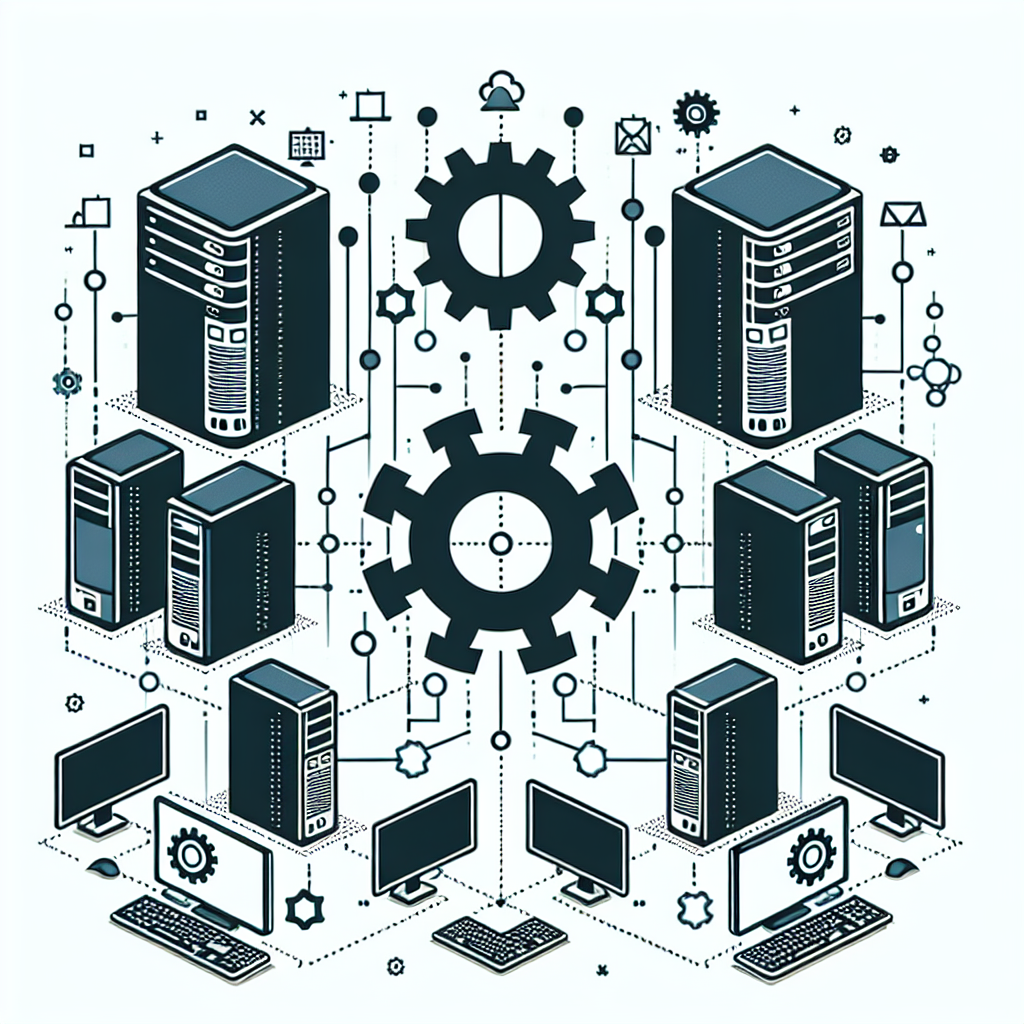Your cart is currently empty!
Tag: Improve

How to Improve Your Help Desk Efficiency: Tips and Strategies
In today’s fast-paced business environment, having an efficient help desk is crucial for providing excellent customer service and resolving issues quickly. A well-functioning help desk not only increases customer satisfaction but also saves time and resources for your organization. If you’re looking to improve your help desk efficiency, here are some tips and strategies to consider:1. Implement ticketing system: A ticketing system is a centralized platform where all customer requests and issues are logged, tracked, and resolved. This system helps streamline communication, prioritize tasks, and ensure that no request falls through the cracks. By using a ticketing system, you can easily assign tasks to the appropriate team members, monitor progress, and provide timely updates to customers.
2. Provide comprehensive training: Proper training is essential for help desk agents to handle various customer inquiries and troubleshoot technical issues effectively. Make sure your team is well-versed in your products or services, familiar with common troubleshooting techniques, and equipped with the necessary tools and resources to assist customers. Regular training sessions and continuous learning opportunities can help improve the skills and knowledge of your help desk agents.
3. Automate repetitive tasks: Automation can significantly increase help desk efficiency by reducing manual tasks and allowing agents to focus on more complex issues. Consider implementing chatbots for handling frequently asked questions, setting up self-service portals for customers to find solutions on their own, and using AI-powered tools for analyzing customer data and predicting potential issues. Automation can help speed up response times, improve accuracy, and free up agents to handle more critical tasks.
4. Prioritize customer feedback: Customer feedback is a valuable source of information for identifying areas of improvement and addressing customer concerns. Encourage customers to provide feedback after interacting with your help desk, whether through surveys, reviews, or direct communication. Use this feedback to identify trends, monitor customer satisfaction levels, and make necessary adjustments to improve the overall help desk experience.
5. Monitor performance metrics: Tracking key performance indicators (KPIs) is essential for evaluating the effectiveness of your help desk and identifying areas for improvement. Some important metrics to monitor include response time, resolution time, first contact resolution rate, customer satisfaction score, and ticket volume. Regularly analyze these metrics to identify trends, set performance goals, and make data-driven decisions to enhance help desk efficiency.
6. Foster a positive work culture: A positive work culture can significantly impact the performance and morale of your help desk team. Encourage open communication, collaboration, and mutual support among team members. Recognize and reward top performers, provide opportunities for professional development, and create a supportive work environment that values employee well-being. A motivated and engaged team is more likely to deliver exceptional customer service and contribute to overall help desk efficiency.
By implementing these tips and strategies, you can improve the efficiency of your help desk and provide better support to your customers. Remember that continuous improvement is key, so regularly evaluate your processes, gather feedback, and make adjustments as needed to ensure that your help desk operates at its best.

How Managed Service Providers Can Improve Efficiency in Your Business
In today’s fast-paced business world, efficiency is key to staying competitive and meeting the demands of customers. Managed Service Providers (MSPs) can play a crucial role in helping businesses improve their efficiency by taking on the responsibility of managing and maintaining their IT infrastructure.MSPs offer a range of services that can help businesses streamline their operations, reduce downtime, and improve overall productivity. By outsourcing IT management to an MSP, businesses can focus on their core activities while leaving the technical complexities to the experts.
One of the main ways MSPs can improve efficiency in a business is by providing proactive monitoring and maintenance of IT systems. This means that potential issues can be identified and addressed before they lead to costly downtime. MSPs can also help businesses implement best practices for security, data backup, and disaster recovery, ensuring that their systems are protected from cyber threats and data loss.
Another way MSPs can improve efficiency is by offering scalable solutions that can grow with a business. As a business expands, its IT needs will also evolve, and MSPs can provide the flexibility to adapt to these changes. Whether it’s adding new users, integrating new software, or expanding to new locations, an MSP can help businesses stay agile and responsive to their changing IT requirements.
Additionally, MSPs can provide businesses with access to the latest technology and expertise without the need for large upfront investments. By leveraging the resources and knowledge of an MSP, businesses can stay ahead of the curve and take advantage of new technologies that can drive innovation and growth.
Overall, working with an MSP can help businesses improve efficiency by allowing them to focus on their core activities, reducing downtime, implementing best practices, scaling their IT systems, and staying ahead of the competition. By partnering with an MSP, businesses can benefit from a more reliable and secure IT infrastructure that enables them to operate more efficiently and effectively.

How to Improve Customer Satisfaction with an Effective Help Desk Strategy
Customer satisfaction is crucial for the success of any business. A happy customer is more likely to become a loyal customer and advocate for your brand. One of the key ways to improve customer satisfaction is by having an effective help desk strategy in place.Here are some tips on how to improve customer satisfaction with an effective help desk strategy:
1. Provide timely and personalized responses: Customers expect quick and personalized responses when they reach out for help. Make sure your help desk team is trained to respond to customer inquiries promptly and in a personalized manner. This can help build trust and improve customer satisfaction.
2. Use the right technology: Investing in the right help desk software can make a big difference in improving customer satisfaction. Choose a platform that allows you to easily track and manage customer inquiries, automate responses, and provide self-service options. This can help streamline your support process and make it more efficient for both your team and your customers.
3. Empower your help desk team: Your help desk team is on the front lines of customer support, so it’s important to empower them with the tools and resources they need to do their job effectively. Provide ongoing training and support, encourage collaboration and communication, and recognize and reward their hard work. A happy and motivated help desk team can have a big impact on customer satisfaction.
4. Gather feedback and make improvements: To ensure your help desk strategy is effective, it’s important to gather feedback from customers and use that information to make improvements. Encourage customers to provide feedback after each interaction, and use that feedback to identify areas for improvement. Making continuous improvements to your help desk strategy can help you better meet the needs and expectations of your customers.
5. Monitor performance metrics: Monitoring key performance metrics can help you track the effectiveness of your help desk strategy and identify areas for improvement. Keep an eye on metrics such as response time, resolution time, customer satisfaction scores, and ticket volume. Use this data to identify trends, make adjustments to your strategy, and ensure you’re providing the best possible support to your customers.
In conclusion, having an effective help desk strategy is essential for improving customer satisfaction. By providing timely and personalized responses, using the right technology, empowering your help desk team, gathering feedback, and monitoring performance metrics, you can create a positive and efficient support experience for your customers. Ultimately, a satisfied customer is more likely to become a loyal customer and advocate for your brand.

How Managed Services Can Improve IT Security and Compliance
In today’s fast-paced and technology-driven world, businesses are increasingly reliant on their IT infrastructure to operate efficiently and effectively. However, with the rise of cyber threats and regulations around data protection, it has become more challenging for organizations to ensure the security and compliance of their IT systems.This is where managed services come into play. Managed services providers offer a range of IT services, including security and compliance management, to help businesses mitigate risks and ensure they are meeting regulatory requirements. By outsourcing these functions to a trusted partner, organizations can benefit from expert guidance, advanced technologies, and round-the-clock monitoring to enhance their overall security posture.
One of the key ways managed services can improve IT security is through proactive monitoring and threat detection. Managed service providers use advanced tools and technologies to continuously monitor networks, applications, and systems for any signs of suspicious activity or potential security breaches. By detecting threats early on, businesses can quickly respond and mitigate the impact of an attack, preventing costly data breaches and downtime.
Additionally, managed services providers can help businesses stay compliant with industry regulations and data protection laws. With the ever-changing regulatory landscape, organizations need to stay up-to-date on the latest requirements and ensure they are implementing the necessary controls to protect sensitive data. Managed services providers have the expertise and resources to help businesses navigate these complexities and ensure they are meeting compliance standards.
Furthermore, managed services can also help businesses improve their overall IT infrastructure by implementing best practices and security measures. Managed service providers can conduct regular security assessments, implement security policies and procedures, and provide ongoing training to employees to enhance their awareness of cyber threats. By taking a proactive approach to security, businesses can better protect their data, systems, and customers from potential cyber attacks.
In conclusion, managed services play a crucial role in improving IT security and compliance for businesses. By partnering with a trusted managed services provider, organizations can benefit from expert guidance, advanced technologies, and proactive monitoring to enhance their security posture and ensure they are meeting regulatory requirements. With the increasing complexity of cyber threats and regulations, investing in managed services is essential for businesses looking to safeguard their data and operations in today’s digital age.

How SLAs Can Improve Customer Satisfaction and Retention
Service Level Agreements (SLAs) are a crucial aspect of any business relationship, as they outline the expectations and responsibilities of both parties. When it comes to customer satisfaction and retention, SLAs can play a significant role in ensuring that customers receive the level of service they expect and deserve.One of the key ways SLAs can improve customer satisfaction is by setting clear expectations from the outset. By clearly outlining the services that will be provided, the level of support that will be offered, and the response times that can be expected, customers know exactly what to expect from their service provider. This transparency helps to build trust and confidence in the relationship, ultimately leading to higher levels of customer satisfaction.
In addition to setting clear expectations, SLAs also provide a framework for measuring and monitoring performance. By establishing key performance indicators (KPIs) and metrics within the SLA, both parties can track progress and identify areas for improvement. This data-driven approach allows for more proactive problem-solving and continuous improvement, ensuring that customers receive the best possible service.
Furthermore, SLAs can help to streamline communication and problem resolution processes. With defined escalation procedures and timelines for issue resolution, customers can rest assured that their concerns will be addressed in a timely and efficient manner. This not only leads to higher levels of customer satisfaction but also helps to build customer loyalty and retention.
Ultimately, SLAs can be a powerful tool for improving customer satisfaction and retention. By setting clear expectations, measuring performance, and streamlining communication processes, businesses can ensure that their customers receive the high-quality service they expect and deserve. Investing in well-crafted SLAs can help businesses to not only meet but exceed customer expectations, leading to increased customer satisfaction and long-term customer loyalty.
Daniil Medvedev pinpoints one area of his game he’s been working to improve in training since shock Australian Open defeat
Daniil Medvedev will be eager to put all of his focus on the Rotterdam Open, but part of him may still be thinking about his disastrous Australian Open.
Medvedev is among the biggest Australian Open losers, having fallen in the second round to American youngster Learner Tien.
And in his first round meeting with Kasidit Samrej, Medvedev was booed by the Australian Open crowd, summarising his disappointing experience in Melbourne.
Medvedev was the fifth seed at the Australian Open, where he is a three-time finalist, having lost last year’s final to Jannik Sinner.
He now moves on from that early exit by taking on Stan Wawrinka at the Rotterdam Open, where Sinner is taking a rest from his recent Grand Slam success.

Photo by Andy Cheung/Getty Images Daniil Medvedev wants to improve confidence after shock Australian Open loss
Medvedev is the second seed in Rotterdam, with the Russian sharing what he has been working on ahead of the event with the ATP Tour website.
“It was a tough result in Australia,” he said. “In a way, it was a good match, but a tough result. I am just trying to look forward and bounce back, that is the only way. I have to try to gain some confidence to win some matches.
“I am trying to get my game more competitive. It is not easy but I am working on a lot of things but I think my confidence is the most important.
“Confidence and the work you put in show in the most important moments of matches, and you try and put the reps in to have that belief in your body.
“I am working on lots of areas. Let’s take volleys. I am not the best at the net on tour but I am capable sometimes of making some amazing volleys in important moments.
“One against Learner in Australia. You work every day on aspects of your game and sometimes they work in matches and sometimes not.
“I feel I am in a good position. I had a very good pre-season and a great week before the Australian Open. I remain calm.
“I am confident I can find my level and play my best in Rotterdam. When you have an amazing week and results and then you lose the next tournament early, you feel your good result is forgotten. That is tennis.
“It works both ways, when you have a bad result people focus on that until you play well again. I hope I can play well here this week at an event I have had success at.”
Daniil Medvedev excited for new generation after Australian Open loss to Learner Tien
Tien was among the rising stars to really shine at the Australian Open, with his fellow NextGen player Joao Fonseca also picking up a top 10 win against Andrey Rublev.
A total of five of the eight players from the 20-and-under tournament in Jeddah in December reached at least the second round in Melbourne, with Tien joined by fellow American Alex Michelsen in making it to round four.
Sharing his thoughts on that new group of ATP players, Medvedev noted: “I think it is normal to have a new generation coming. I think every generation probably had this. Young guys coming and beating top 10 players at majors.
“Learner played a great match and was able to win the next one even when we finished at three in the morning. So that showed he was ready for it and a good sign.
Daniil Medvedev Grand Slam finals “But with this new generation, there are a lot of good young guys. Some generations have more players coming through like this than others, but there are always great players coming.
“Let’s see what they are able to do over the coming period, that is tough. But for sure they have a very strong generation.”
Related Topics
After his surprising early exit at the Australian Open, Daniil Medvedev has been hard at work in training to improve one specific area of his game. The Russian tennis star recently revealed that he has been focusing on his mental toughness and staying calm under pressure.In a recent interview, Medvedev admitted that he struggled to maintain his composure during his match at the Australian Open, which ultimately led to his defeat. He acknowledged that he needs to work on controlling his emotions and staying focused, especially in crucial moments.
“I know that I have the skills and the talent to compete at the highest level, but I need to work on my mental game to ensure that I can perform at my best when it matters most,” Medvedev said.
The 25-year-old has been working closely with his coaches to develop strategies to improve his mental strength and resilience on the court. He has been practicing mindfulness techniques and visualization exercises to help him stay calm and composed during matches.
“I have been putting in the hard work in training to make sure that I can handle the pressure and stay focused on my game,” Medvedev added.
With his sights set on future tournaments, including the upcoming French Open, Medvedev is determined to bounce back stronger than ever. By pinpointing and addressing this key area of improvement, he is confident that he can elevate his game to new heights and compete with the best in the world.
Tags:
- Daniil Medvedev
- Tennis player
- Australian Open
- Training
- Improvement
- Shock defeat
- Performance improvement
- Sports training
- Athlete development
- Tennis strategy
#Daniil #Medvedev #pinpoints #area #game #hes #working #improve #training #shock #Australian #Open #defeat

How Proactive Maintenance Can Improve Efficiency and Productivity
Proactive maintenance is a strategy that focuses on preventing equipment failure before it occurs, rather than waiting for a breakdown to happen and then fixing it. This approach can significantly improve efficiency and productivity in a variety of industries, from manufacturing to healthcare.One of the key benefits of proactive maintenance is that it helps to avoid costly downtime. When equipment breaks down unexpectedly, it can take hours or even days to repair, leading to lost production time and revenue. By regularly inspecting and maintaining equipment, issues can be identified and addressed before they cause a breakdown, reducing the risk of unplanned downtime.
Proactive maintenance also helps to extend the lifespan of equipment. Regular maintenance checks can identify wear and tear on components, allowing them to be replaced or repaired before they fail completely. This not only saves money on expensive repairs, but also prolongs the life of the equipment, reducing the need for costly replacements.
In addition to preventing breakdowns and extending equipment lifespan, proactive maintenance can also improve efficiency and productivity in other ways. For example, by keeping equipment in optimal working condition, it can operate more efficiently, using less energy and resources to perform the same tasks. This can lead to cost savings and increased output.
Furthermore, proactive maintenance can help to improve safety in the workplace. Regular inspections can identify potential hazards or safety risks, allowing them to be addressed before they cause an accident or injury. This not only protects employees, but also helps to avoid costly fines and legal issues that can arise from workplace accidents.
Overall, proactive maintenance is a proactive approach that can have a positive impact on efficiency, productivity, and safety in any industry. By investing in regular maintenance checks and inspections, businesses can reduce downtime, extend equipment lifespan, improve efficiency, and enhance workplace safety. This can lead to cost savings, increased output, and a more efficient and productive operation overall.

5 Ways Remote Monitoring Can Improve Productivity
In today’s fast-paced business world, remote monitoring has become an essential tool for improving productivity. With employees working from various locations and devices, it’s important for businesses to have a way to keep track of their work and ensure they are staying on track. Remote monitoring allows businesses to do just that, by providing real-time insights into employee activity and performance. Here are 5 ways remote monitoring can improve productivity:1. Increased accountability: Remote monitoring allows managers to track employee activity and ensure they are staying on task. This increased level of accountability can help employees stay focused and motivated, knowing that their work is being monitored.
2. Better time management: Remote monitoring can help businesses track how employees are spending their time throughout the day. This can help identify any time-wasting activities or inefficiencies, allowing for better time management and improved productivity.
3. Improved communication: Remote monitoring tools often include features such as messaging and video conferencing, which can help improve communication among remote teams. This can help teams collaborate more effectively and stay connected, leading to improved productivity.
4. Real-time insights: Remote monitoring provides businesses with real-time insights into employee activity and performance. This can help managers quickly identify any issues or bottlenecks that may be impacting productivity, allowing for quick action to be taken to address them.
5. Enhanced security: Remote monitoring can help businesses ensure that sensitive data and information is being handled securely. By monitoring employee activity, businesses can identify any potential security risks and take steps to mitigate them, helping to protect valuable assets and maintain business continuity.
Overall, remote monitoring can be a powerful tool for improving productivity in today’s remote work environment. By providing increased accountability, better time management, improved communication, real-time insights, and enhanced security, businesses can help ensure that their remote teams are working efficiently and effectively.

The Benefits of Managed Service Providers: How MSPs Can Improve Your Business’s Efficiency
In today’s fast-paced business world, efficiency is key to staying ahead of the competition. One way to achieve this efficiency is by partnering with a managed service provider (MSP). Managed service providers are third-party companies that take on the responsibility of managing a business’s IT infrastructure and services. By outsourcing these tasks to an MSP, businesses can focus on their core operations and leave the technical aspects to the experts. Here are some of the benefits of working with an MSP and how they can improve your business’s efficiency.1. Increased Focus on Core Business Activities
By entrusting the management of your IT infrastructure to an MSP, your team can focus on what they do best – running the business. This allows employees to concentrate on strategic initiatives and revenue-generating activities, rather than being bogged down by technical issues and maintenance tasks.
2. Access to Expertise and Specialized Skills
Managed service providers have a team of highly skilled professionals with expertise in various areas of IT. By working with an MSP, businesses can tap into this pool of talent and benefit from specialized skills that may not be available in-house. This ensures that your IT infrastructure is in good hands and operating at peak performance.
3. Proactive Monitoring and Maintenance
MSPs provide 24/7 monitoring and maintenance of your IT systems to prevent potential issues before they occur. This proactive approach helps to minimize downtime, improve system reliability, and ensure that your business operations run smoothly at all times. With regular updates and patches, MSPs can also enhance the security of your IT infrastructure and protect your sensitive data from cyber threats.
4. Scalability and Flexibility
As your business grows, your IT needs will evolve as well. Managed service providers offer scalable solutions that can be customized to meet your changing requirements. Whether you need to add new users, upgrade software, or expand your network, MSPs can adapt to these changes quickly and efficiently. This flexibility allows businesses to stay agile and responsive to market demands without the hassle of managing IT infrastructure internally.
5. Cost-Effective Solutions
Outsourcing IT services to an MSP can result in cost savings for businesses. MSPs typically offer subscription-based pricing models that allow businesses to pay for only the services they need, without incurring additional overhead costs. By outsourcing IT management to an MSP, businesses can also avoid the expenses associated with hiring and training in-house IT staff, as well as the costs of purchasing and maintaining hardware and software.
In conclusion, managed service providers play a crucial role in improving a business’s efficiency by taking on the responsibility of managing its IT infrastructure. By partnering with an MSP, businesses can benefit from increased focus on core activities, access to specialized skills, proactive monitoring and maintenance, scalability and flexibility, and cost-effective solutions. In today’s competitive business landscape, working with an MSP can give your business the edge it needs to succeed.

How IT Consulting Can Help Improve Your Company’s Efficiency
In today’s fast-paced business world, staying ahead of the competition requires constant innovation and optimization of processes. One way to achieve this is through IT consulting, a service that can help improve your company’s efficiency and streamline operations.IT consulting involves working with a team of experts who specialize in technology and business processes. These professionals can analyze your company’s current IT infrastructure, identify inefficiencies, and develop a customized plan to address them. By leveraging the latest technology and best practices, IT consultants can help your company operate more efficiently and effectively.
One of the key ways IT consulting can improve your company’s efficiency is by optimizing your IT systems. Outdated or inefficient systems can slow down operations and hinder productivity. IT consultants can assess your current systems and recommend upgrades or replacements that better meet your company’s needs. This can lead to faster processing times, improved data management, and enhanced security measures.
Additionally, IT consulting can help automate repetitive tasks and streamline processes. By implementing software solutions and workflows that eliminate manual work, your company can save time and resources. This allows employees to focus on more strategic tasks that drive innovation and growth.
IT consultants can also help improve communication and collaboration within your company. By implementing tools such as cloud-based file sharing and communication platforms, employees can work more effectively together, regardless of their location. This can lead to better teamwork, faster decision-making, and increased productivity.
Furthermore, IT consulting can help your company stay ahead of the curve when it comes to technology trends. By keeping up-to-date with the latest advancements in IT, consultants can recommend solutions that help your company remain competitive in the market. Whether it’s implementing artificial intelligence, machine learning, or blockchain technology, IT consultants can help you leverage these tools to improve efficiency and drive growth.
In conclusion, IT consulting can be a valuable resource for companies looking to improve their efficiency and competitiveness. By optimizing IT systems, streamlining processes, enhancing communication, and staying current with technology trends, IT consultants can help your company operate more effectively and achieve its business goals. If you’re looking to take your company to the next level, consider working with an IT consulting firm to unlock the full potential of your business.
